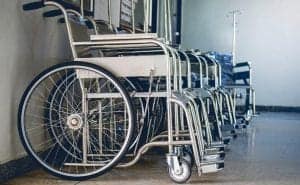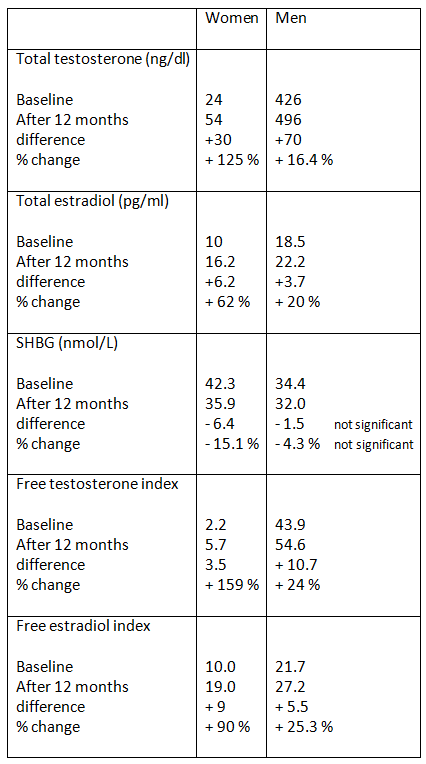In prior posts, I have discussed my hypothesis that growth hormone and related growth factors, as a possible therapy for connective tissue/joint degeneration in active populations. The study below finds testosterone therapy (TRT ) appears highly valuable treatment in SCI; to prevent the loss of skeletal muscle post SCI. These results do not surprise me in the least and why this is not a common therapy for people with SCI is a tragedy in my view.
 If you, or someone you know, has suffered a SCI, I highly recommend you send this info to your/their doctor and pursue this as a possible option. It’s important to note that testosterone deficiency is common after SCI, and according to the U.S. Department of Veterans Affairs SCI unit:
If you, or someone you know, has suffered a SCI, I highly recommend you send this info to your/their doctor and pursue this as a possible option. It’s important to note that testosterone deficiency is common after SCI, and according to the U.S. Department of Veterans Affairs SCI unit:
“These findings confirm both a substantial population of men with SCI and with testosterone deficiency, and a significant association between testosterone level and severity of SCI. Measuring serum total testosterone levels should be included in standard screenings for patients with SCI…”
I can say, a very common report of those who go on TRT is a big reduction in general aches and pains in my experience, and again, it makes perfect sense to me. The future treatment of SCI will be the of use various growth factors and other modalities (such as stem cell therapy) to re grow/re connect the spinal cord. That technology is much closer than people realize, but it seems the med/sci community very slow to pursue this area as quickly as they should. Obviously, this approach could be used to repair damaged nerves and other tissues far less challenging than repairing a severely damage or severed spinal cord.
Useful summary info from this study Effects of testosterone replacement therapy on skeletal muscle after spinal cord injury:
“The most important finding of this study was that TRT ameliorated the decrease in fiber CSA resulting from SCI. TRT also attenuated the slow to fast fiber type shift as well as the decrease in oxidative enzyme activity. To our knowledge, this is the first study to investigate the potential of TRT to prevent atrophy in SCI. TRT in aging sarcopenia and in other diseases with muscle wasting (for example, AIDS) results in favorable effects on bone, muscle size and strength in both low-average and hypogonadal men.19 Increases in muscle CSA were equal, if not greater in TRT only groups than in exercise groups without TRT.20 These data and ours for SCI both demonstrate a positive effect of TRT on muscle size without traditional overload…”
Effects of testosterone replacement therapy on skeletal muscle after spinal cord injury
Abstract
Study design: Randomized control.
Objective: To examine the effects of testosterone replacement therapy (TRT) on skeletal muscle 11 weeks after complete SCI.
Setting: Athens, Georgia USA.
Methods: Soleus (SOL), gastrocnemius (GA), tibialis anterior (TA), vastus lateralis (VL) and triceps brachii (TRI) muscles were taken from twelve young male Charles River rats 11 weeks after complete SCI (T-9 transection, n=8) or sham surgery (n=4). Rats received either TRT (two 5 cm capsules, n=4) or empty capsules (n=8) implanted at surgery. Muscle samples were sectioned and fibers analyzed qualitatively for myosin ATPase and quantitatively for succinate dehydrogenase (SDH), alpha-glycerol-phosphate dehydrogenase (GPDH) and actomyosin ATPase (qATPase) activities using standard techniques.
Results: SCI decreased average fiber size (49plusminus4%) in affected muscles and the percentage of slow fibers in SOL (93plusminus3% to 17plusminus2%). In addition, there was a decrease in SDH and an increase in GPDH and qATPase activities across the four hind-limb muscles of the SCI animals. Fiber size in the TRI was increased (31plusminus2%) by SCI while enzyme activities were not altered. Average fiber size across the four hind limb muscles was decreased by only 30% in TRT SCI animals and their SOL contained 39plusminus2% slow fibers. TRT also attenuated changes in enzyme activities. There was no effect of TRT on the TRI relative to SCI.
Conclusions: TRT was effective in attenuating alterations in myofibrillar proteins during 11 weeks of SCI in affected skelatal muscles.
Additional related studies of interest:
Exogenous testosterone prevents motoneuron atrophy induced by contralateral motoneuron depletion.
Fargo KN1, Sengelaub DR. J Neurobiol. 2004 Sep 5;60(3):348-59.
Abstract
Gonadal steroids exhibit neuroprotective and neurotherapeutic effects. The lumbar spinal cord of male rats contains a highly androgen-sensitive population of motoneurons, the spinal nucleus of the bulbocavernosus (SNB), whose morphology and function are dependent on testosterone in adulthood. Unilateral SNB motoneuron depletion induces dendritic atrophy in contralateral SNB motoneurons, but this atrophy is reversed in previously castrated males treated with testosterone. In the present experiment we test the hypothesis that the morphology of SNB motoneurons is protected from atrophy after contralateral motoneuron depletion by exogenous testosterone alone (i.e., with no delay between castration and testosterone replacement). We unilaterally depleted SNB motoneurons by intramuscular injection of cholera toxin conjugated saporin. Simultaneously, some saporin-injected rats were castrated and immediately given replacement testosterone. Four weeks later, contralateral SNB motoneurons were labeled with cholera toxin conjugated HRP, soma sizes were measured, and dendritic arbors were reconstructed. Contralateral SNB motoneuron depletion induced somal atrophy and dendritic retraction, but testosterone treatment prevented both of these effects. Thus, the presence of high-normal levels of testosterone prevents motoneuron atrophy induced by contralateral motoneuron depletion. These data support a therapeutic role for testosterone in preventing atrophy induced by motoneuron injury.
Prevalence of testosterone deficiency after spinal cord injury.2011
Oct;3(10):929-32.
Abstract
OBJECTIVE:
To define the prevalence of testosterone deficiency in persons with chronic spinal cord injury (SCI) and to identify factors associated with this deficiency.
DESIGN:
Cross-sectional study.
SETTING:
A U.S. Department of Veterans Affairs SCI unit.
PARTICIPANTS:
Participants (n = 60) included male veterans completing annual evaluations from July 2006 to April 2007.
METHODS:
In addition to routine annual evaluation laboratory examination, which included measurements of serum albumin levels, participants underwent measurements of serum total testosterone, luteinizing hormone, follicle stimulating hormone, and prolactin levels. Outcome measures included the prevalence of testosterone deficiency (defined as total serum testosterone <325 ng/dL) and the relationship of testosterone level with participant’s age, serum albumin level, narcotic medication use, time since injury, American Spinal Injury Association Impairment Scale (AIS) grade, and neurologic level of injury.
RESULTS:
A low serum testosterone level (<325 ng/dL) was detected in 43.3% of participants. The testosterone level was significantly associated with severity of injury as defined by AIS grade (t = -2.59, P = .012). The prevalence of testosterone deficiency was significantly greater in participants with motor complete (AIS A and B) injuries compared with those with motor incomplete (AIS C, D, and E) injuries. Testosterone levels were significantly lower in participants who were taking narcotic medications for pain management (t = -0.25, P < .05). There was no relationship between the use of narcotic medications and severity of injury. Given the small number of participants, the SCI levels, age, duration of injuries, serum albumin levels, and serum levels of luteinizing hormone, follicle stimulating hormone, and prolactin did not reach statistical significance in predicting testosterone level.
CONCLUSIONS:
These findings confirm both a substantial population of men with SCI and with testosterone deficiency, and a significant association between testosterone level and severity of SCI. Measuring serum total testosterone levels should be included in standard screenings for patients with SCI, particularly those with motor complete injuries.
Will Brink is the owner of the Brinkzone Blog. Will has over 30 years experience as a respected author, columnist and consultant, to the supplement, fitness, bodybuilding, and weight loss industry and has been extensively published. Will graduated from Harvard University with a concentration in the natural sciences, and is a consultant to major supplement, dairy, and pharmaceutical companies.
His often ground breaking articles can be found in publications such as Lets Live, Muscle Media 2000, MuscleMag International, The Life Extension Magazine, Muscle n Fitness, Inside Karate, Exercise For Men Only, Body International, Power, Oxygen, Penthouse, Women’s World and The Townsend Letter For Doctors.
He’s also been published in peer reviewed journals.
Will is the author of the popular e-books, both accompanied by private members forum access , Bodybuilding Revealed & Fat Loss Revealed.
You can also buy Will’s other books on Amazon, Apple iBook, and Barnes and Noble.






Hi Will,
The problem here is that you are expecting our scientific community (physicians) to use independent judgment that is informed by experience and evidence. Instead we are treated by those that have been indoctrinated in customs, traditions and standard of care.
Fill in the blank:
The high school valedictorian is the most likely to ___________. Most people would say something like succeed. When you look at the studies of how these very high performing students do after graduation, you will find that they generally underperform. The reason for this is that the valedictorian is actually most likely to follow. They have spent their entire academic career doing exactly what was expected. They can’t afford to take risks. Since they don’t take risks and fail, they don’t learn how to resolve the problems and conflict that arise from these situations.
Unfortunately it’s becoming more and more competitive at the University level. To get into the University of CA right out of high school you need at least a 4.0 gpa. This highly competitive nature of the admissions process is biased toward the type of student I mentioned above.
Medical school is even more competitive. By the time a student makes it that far, all that’s left is an indoctrinated robot that that learned to follow direction or fail.
Fast forward to post residency and private practice – evidence becomes available that contradicts their customs, traditions and standard of care. There is no incentive for them to try something new. They aren’t risk takers. Even if they were to try something new, they wouldn’t know how to solve the problem if it goes sideways – they didn’t really get into trouble.
Sadly this is permeating all scientific disciplines. Look at how many times you hear educated professions making statements like “the consensus among scientists is” as a way of proving a point.
When my father was alive his endocrinologist told me he couldn’t do something because “the consensus is” and “I feel” as a legitimate medical position. Essentially he gave me a political and emotional reason. Pathetic.
Thankfully there is still a minority that make it through the system with a high gpa that want to lead and not follow. It’s this small group that take the risk of establishing their own clinic and base their practice on evidence.
This, of course, is why you don’t see the MD in the local medical group prescribing these therapies that can have such a dramatic impact on quality of life. As you mentioned above, it is a tragedy that more people are not being competently treated.
You make some valid points Jim, but I do find younger newer docs tend to be more open minded and willing to try out of the box treatments then their older counterparts on average, and like any profession, only a small % are any good at what they do. That goes for doctors, lawyers, cops, painters, etc and no amount of education can alter that.
I run into this issue frequently: A friend, colleague, family member has an obvious hormone deficiency that is impacting quality of life. Family doc doesn’t agree. Paying out of pocket for a specialist is one option. Unfortunately many can’t handle the cost. I typically suggest that they look for a network doc that has an interest in this practice area. Unfortunately I have not had one person report back that they were successful. How do you approach this problem?
I guess, best to find a primary/GP who “gets it” and will work with you. That’s not always easy, but it can be done. Just takes some leg work and searching around in my experience.
WOW! YOU ARE SO RIGHT. DON’T MAKE WAVES—MAKE MONEY. KEEP DOING THE SAME THING OVER + OVER AND HOPE FOR BETTER RESULTS NEXT TIME. RICH
Is that suppose to make sense in the context of this topic? Why are you yelling at me? All caps = yelling.
Sorry Will: This was meant for Jim’s comment . Not your reply. Rich
Hello Will ,
I am from India and would like to know wheather there is such treatment avaibale in Mumbai , India.
Also I had heard about the Pain Injection Modular Therapy for back pain , Neck pain etc .
Kindly suggest ..
Regards
Vinay Joshi
I am not from India, and so can’t tell you what treatments exist in Mumbai.
Hi Will,
My mum has suffered a spinal chord injury late 2012. The injury was the result of an inflammation in the spinal chord in her neck, caused by her own immune system. Even though she’s improved quite a lot through intensive therapy over the past 1.5 years, she’s (both physically and emotionally) not the woman she used to be.
I am having trouble extracting from the study, whether TRT might be beneficial in some way for her. Particularly, her control over her muscles has been affected by the damaged spinal chord. What’s your say on this?
I know her doctor is a very open-minded person, so he might go for it, but I would like to hear your take on my story and whether TRT is a viable option. I could then at least propose it to her and her doctor.
Many thanks in advance!
Martijn
I’d recommend you send the info I posted to her doc, and take it from there. The data above makes it very clear in my view of benefits of TRT in people with SCIs, but not knowing anything about the nature of her injuries and medical history, etc, best discussed with her doctor(s).
Good luck.
Hi Will,
Just wanted to let you know that I appreciate your answer and totally understand your conservative answer, considering your lack of knowledge on the nature of my mum’s spinal chord injury. I have spent the last months looking at various therapies, which could help her improve. However, just yesterday I finally bit the bullet and told my parents about TRT and this article and that it is an option we should at least take up with her doctor. My parents were very interested and so I will forward the link to this article to them and hope we take it from there.
I suggest that I keep you in the loop in any developments, as it might be something you want to add to this article, should my mum undergo a form of TRT and I can share the results with you.
Thanks again for taking the time to put this article up on your website! I am a big fan of your science-based approach to performance in the broadest definition possible!
Kind regards,
Martijn van Amstel
Martin, it’s great that hear doctors are interested and open minded to the idea and i hope they take a serious close look at it. Might very much be worth a try.